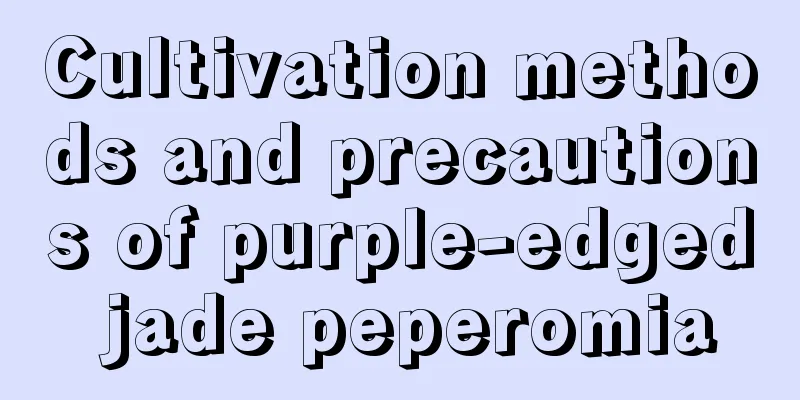Cultivation methods and precautions of purple-edged jade peperomia

1. Maintenance methods1. Temperature: Twenty-five to thirty degrees is more suitable, which can be seen from its distribution range. In addition, it is not cold-resistant, and the cold climate in winter can cause it great harm and may even cause its death. Therefore, try not to drop below ten degrees in winter. 2. Light: It prefers light, and it cannot carry out photosynthesis without sunlight. But direct sunlight can also cause it damage, especially its leaves. Therefore, it is necessary to shade it in summer or move it to a semi-shaded place. In other seasons, it can be placed in a place with sufficient sunlight, and the best lighting time is about six hours. 3. Watering: It likes moisture and has high requirements for air humidity. Therefore, in addition to normal watering, you also need to spray some water when it is dry. 4. Fertilization: It needs fertilizer, but not too much. Normally, it can be applied once every ten days or half a month, but the concentration needs to be strictly controlled, because concentrated fertilizer is very harmful to it. 2. Breeding techniques1. Reproduction: You can use the cutting method. Best time to visit is April to May. Choose top, strong branches, preferably about five centimeters in length. Cut off the lower half of the leaves and leave the upper half. Then, insert it into the sand bed. Note that it is best to insert it at an angle. After about ten days or half a month, it will take root. 2. Repotting: Purple-edged Jade Peperomia has certain requirements on the quality of the substrate. Generally speaking, the frequency of repotting can be two or three years. When preparing, you can use leaf mold, peat soil, perlite, sand and other materials. After repotting, the temperature should be between 18 and 20 degrees, otherwise it will be difficult for the plant to adapt to the new environment. 3. Problem diagnosis and treatment1. Diseases: There are not many types of diseases and their frequency is not high. Occasionally there are "stem rot" and "leaf spot", which can be treated with carbendazim and other drugs. In addition, more attention should be paid to auxiliary measures such as ventilation. 2. Pests: Mainly scale insects and slugs, which can be controlled by various pesticides. IV. Other issues1. Toxicity: It is a non-toxic and harmless variety. Moreover, its ability to absorb harmful gases is very strong. 2. Can it be raised at home? It not only has a strong purifying effect, but also has a great ornamental effect. It is a foliage plant. |
<<: Cultivation methods and precautions of Fugui seeds
>>: Does the Bilei drum prefer yin or yang?
Recommend
Cultivation method of the genus Echinops
1. Temperature Almost all plants of the genus Cal...
Disease and Pest Control of Tea Rose
1. Powdery mildew Powdery mildew is a common dise...
Can gardenia be placed in the bedroom?
Is it okay to put it in the bedroom? Can it be pl...
How to cultivate lotus orchid
1. Soil It is best to use loose, well-drained soi...
Why does eggplant bloom but not bear fruit?
Eggplant, a vegetable crop originating from tropi...
How to care for grafted Christmas cactus
1. Lighting The newly connected ones can be place...
When is the best time to harvest Chinese cabbage?
Chinese cabbage harvest time The best time to har...
Don’t buy soil anymore when growing flowers. Just go out and dig some up. It’s convenient and saves money!
1. Pine Needle Soil There are several pine trees ...
How to make a bridal bouquet
1. Make a bouquet model After choosing the materi...
Can the horse hoof gold be hydroponically cultivated?
Can Dichondra chinensis be hydroponically cultiva...
Where does saffron grow? Where does it usually grow?
Where does saffron like to grow? Saffron generall...
How to grow African jasmine so that it blooms
African jasmine flowering time African jasmine ne...
What to do if chrysanthemums do not bud or bloom
The reason why chrysanthemums do not bud or bloom...
The difference between creeper and trachelospermum
1. Attributes Ivy: Although it and Trachelospermu...
Clivia cultivation method, what fertilizer to use for Clivia
1. Breeding methods 1. Soil: Clivia is usually pl...









